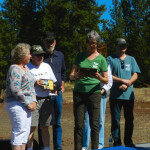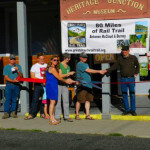Great Shasta Rail Trail Opens
The Grand Opening of the Great Shasta Rail Trail (GSRT) was celebrated in two ceremonies held in McCloud and Burney. The ceremonies were sponsored by the Great Shasta Rail Trail Association (GSRTA) and the Shasta Land Trust (SLA).
On Saturday, September 26, at 4:30 p.m., a ribbon cutting ceremony was held at the Heritage Junction Museum in McCloud at the conclusion of the 2015 McCloud Bike-oberfest. April Gray, President of GSRTA, and Anne Murphy, Executive Director of SLA cut the ribbon. About 100 people attended the opening.
Gray said, “This is a big deal. We have been working on this for six years.”
The ceremony officially opened two sections of the trail, one 13-mile section from Pilgrim Creek Road to Bartle and one 13-mile branch trail from Bartle to Hambone.
On Sunday, September 27, a second ceremony was held at the Burney Depot Trailhead opening the 11-mile section from Burney to the Lake Britton “Stand By Me” railroad trestle. After speeches, Gray presented plaques to Joe Studenicka and Laura Pauley for their work as members of Save Burney Falls, the local non-profit organization that conceived the idea of converting the rail line to a trail and eventually evolved into GSRTA.
Studenicka gave a talk recognizing others who had helped develop the trail and then presented April Gray with one of the golden spikes from the original opening ceremony of the McCloud Railway to Burney in 1956. Gray, Studenicka, and Pauley then cut the ribbon.
A highlight of the afternoon occurred when Studenicka led a throng of bikers, hikers, and joggers onto the trail for a half-mile jaunt up the trail and back.
Three sections of the trail totaling 37 miles are now open for non-motorized use, including hiking, bicycling, horseback riding, snowshoeing, and cross-country skiing.
The Shasta Land Trust, the McCloud Local First Network, the Volcanic Legacy Community Partnership, the McCloud Trail Association, and the Burney and Fall River Chambers of Commerce have been working cooperatively for five years to convert the 80 miles of railroad track of the McCloud Railroad between McCloud and Burney to a public recreation trail.
The GSRT will include a central 53-mile trail from Burney Depot to Pilgrim Creek Road, three miles east of McCloud, and two branch trails. One of the branches leads from Bartle to Hambone. The second splits off between Burney and Hwy 89 and heads toward Goose Valley.
In 2013, GSRTA was created to own the property and manage the trail. The Shasta Land Trust subsequently received a $350,000 grant from the California Transportation Commission which enabled them to buy the property from 4 Rails owned by Jeff Forbis. Shasta Land Trust will deed the property to GSRTA.
Current board members of GSRTA include Jerry Harmon and Bob Polkinghorn from Mt. Shasta; April Gray from McCloud; Tina Peluso and Bill Campbell from Fall River Valley; Pat Thompson and Dr. Henry Patterson from Burney; Elizabeth Norton from Susanville; and Ben Miles, past executive director of SLA, who now lives in Kentucky.
Polkinghorn, secretary of the Board, said, “This is really a big milestone for Burney, McCloud, Fall River Valley and the recreational system in this area. We have a big vision.”
Speaking to GSRT supporters who attended the ceremonies, Miles explained that while celebrating the purchase of the property and opening of a portion of the trail, there is much work ahead.
Signs need to be posted welcoming non-motorized trail users and closing the trail to motor vehicles. Over 50 miles of the trail remain to be opened. Some of these will require major infrastructure improvements. Six bridges and the 462-foot-long railroad trestle over Lake Britton need to be restored. The trail surface will need to be improved and maintained. Additional trailhead facilities and amenities will be added and interpretive and educational markers placed along the trail.
GSRTA plans to achieve this by implementing a five-year plan evolving through six phases. In order to do so a lot of funding and many volunteers will be needed.
Thanks to the Pit River Country News for writing this article.









